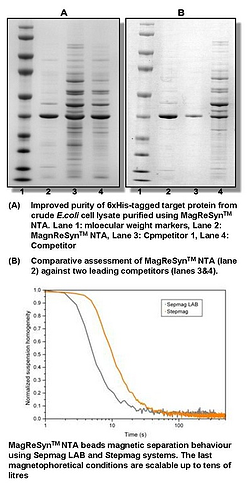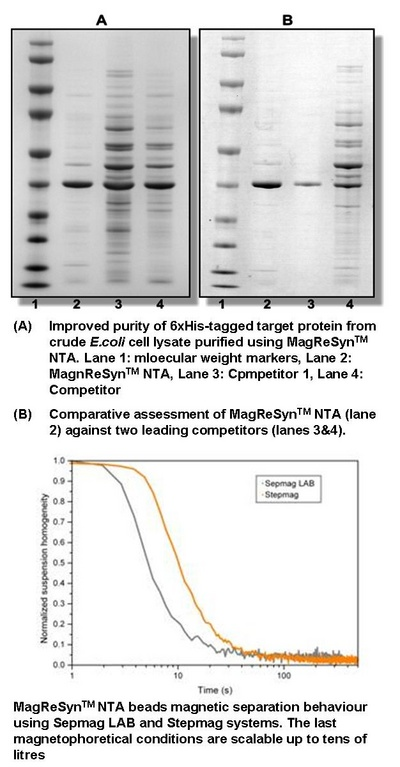Traditional magnetic beads are comprised of solid microspheres. Unfortunately, binding capacity is limited by the amount of area on the surface of these magnetic beads.
 Resyn Biosciences (www.resynbio.com), based in South Africa, has developed a novel, patented [1] microsphere technology platform comprising of a loosely linked polyethileneimine matrix that allows penetration of biological and synthetic molecules throughout the internal and external volume of their microspheres. The result is a significant increase in surface area for binding of molecules, having functional group density of 3500 micromoles/g (vs 300-600 micromoles/g of standard magnetic beads)
Resyn Biosciences (www.resynbio.com), based in South Africa, has developed a novel, patented [1] microsphere technology platform comprising of a loosely linked polyethileneimine matrix that allows penetration of biological and synthetic molecules throughout the internal and external volume of their microspheres. The result is a significant increase in surface area for binding of molecules, having functional group density of 3500 micromoles/g (vs 300-600 micromoles/g of standard magnetic beads)
To unleash the full potential of these high binding capacity microspheres (see figure), it is necessary to utilize a Biomagnetic Separation system that guarantees the complete recovery of the magnetic beads.
Sepmaghomogenous Biomagnetic Separation systems have shown superior recovery when compared to standard magnets [2], shorter separation times and easy scale-up of the process (from millilitres to tens of litres using the same technology).
Because of Sepmag’s unique and efficient magnetic separation technology, Resyn Biosciences has partnered withSepmagto provide precision magnetophoresis systems for homogenous magnetic microsphere separation.
For further information, please visit Resyn Biosciences at BIO 2012 (booth 3175). Information can also be obtained electronically by contacting Isak Gerber at info@resynbio.com or please visit the Resyn Biosciences website at www.resynbio.com.
Sepmagwill not exhibit at BIO 2012, but our representatives will be in attendance. To request a meeting, please contact northamerica@sepmag.eu. Sepmag will be exhibiting at the AACC 2012 conference July 17-19 in Los Angeles.
References:
[1] Patents US2010267108, EP2205665
[2] J.L.Corchero et al, Biochemical Engineering Journal,Volume 67, 15 August 2012, Pages 20–27



